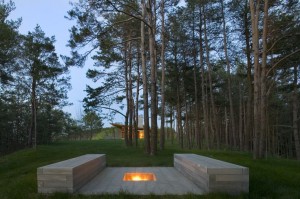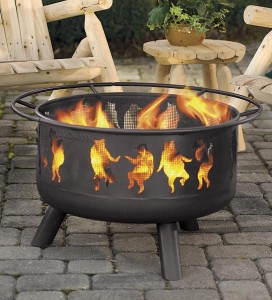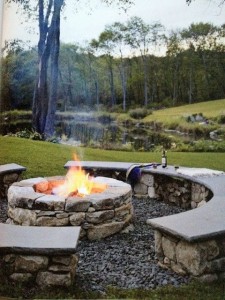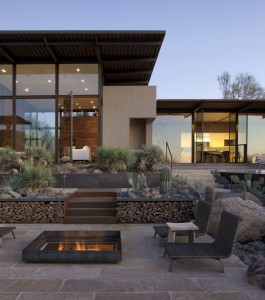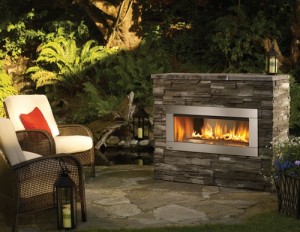Fire has been an essential part of outdoor living since long before patios and fireplaces even existed. Fire can bring elements of drama, romance and even fun to any outdoor design. People just love to gather around fire features.
If you’re thinking about adding the drama of fire to your yard or just thinking about cozy intimate nights around a fire pit, read on! We’ll show you how to incorporate the right kind of fire feature into your landscape to get the effect you want. So, let’s start at the beginning….
The Basics of Fire Pits and Outdoor Fireplaces
Before we start stacking wood, there are a few basic things to consider about fire features. First of all, remember that the design and placement of your fire feature will have a dramatic effect on your landscape and the way you enjoy your yard. Second, most fire features are large, permanent structures that can easily become eyesores if not used and integrated properly into the landscape and the lifestyle of the homeowners.
So, give some serious thought to the design and placement of your fire feature before building. We’ll show you how to avoid the pitfalls and create a beautiful focal point that will enrich your home for years to come.
As with any design process, the first step should be to define your goal. Ask yourself why you want a fire pit or outdoor fireplace in your yard. Picture yourself using it. Are you alone or sharing an intimate moment with a loved one? Is it a cozy, intimate environment? Is it a gathering place for a large family? Is it the center of attention for a large social gathering? Is it a place for kids to gather? Maybe it’s a quiet adult getaway where people relax and enjoy quiet evenings. These questions are important. Think about your goal carefully before making any design decisions.
Fireplace or Fire Pit?
Fire features generally come in two groups: fire pits and outdoor fireplaces. The main difference between the two is that fire pits allow seating all around them and fireplaces usually have seating only in front. This may not seem like a such a big difference at first, but it will have a major effect on the way you or your guests enjoy your fire feature. The seating around a fire pit promotes a much more social and interactive environment.
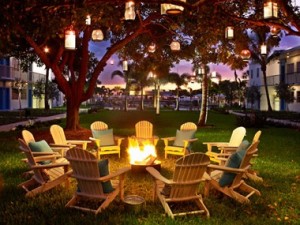
Fire pits are more social than fireplaces. People tend to gather in a large circle around a fire pit
People are typically seated in a large circle around the fire. Voices are loud, so as to be heard across the fire feature. The fire is very accessible, so interaction, like toasting marshmallows or poking at the fire will be frequent. A fireplace creates a much more quiet, peaceful and possibly romantic setting. People seated in front of a fireplace are all facing the same way as opposed to facing each other. This promotes a quieter and more relaxed environment. People are much less likely to interact with the fire directly in a fireplace. The fire will most likely encourage reflection and quiet conversation.
Designing a Fire Pit
If you decide to go with a fire pit, here are a few things to consider….
Where should I put it? Where you place your fire pit is extremely important. First, consult your local construction codes. There may be rules about how close a fire feature can be to your home. Calling your town building inspector may be the easiest way to check.
It’s also important to consider if you want your fire pit to be part of your home or a separate entity. If a fire pit is close the house, it will generally blend into the social activity around the house. If it’s placed far away, it will become its own separate social gathering place, separate from what is going on around the house. This will hold true during social gatherings and also when just your family is at home. Fire pits also tend to attract the younger crowd at gatherings, so if you’d rather the noisy teenagers have their own separate space, by all means put the fire pit far away from the house. It’s a good idea to have the fire pit in view of the house and the main social gathering area so that you can check on it as needed. An unattended fire out of site is never a good idea. If you want your fire pit to be the center of your social gathering, make sure you place it relatively close to house (again, check local codes) and have plenty of room around it for gathering.
Think about where your wood will come from. You should design a stacking location close to your fire pit that can accommodate at least a full evening’s worth of wood. No one wants to lug wood long distances in the middle of a party.
There are also many great moveable fire pits and other fire features like chimineas. You can get non-permanent fire features that range from very inexpensive fire bowls to ultra-chic art pieces. If you are not ready to commit to a permanent structure or just like the idea of being able to move your fire around, consider a moveable fire pit.
How big should my fire pit be? This is a great question. For some, bigger is better, but there are some drawbacks to a large fire pit. Most fire pits tend to have an inside diameter of about 2-3 feet.
This gives enough room for a small log fire. Keeping your fire this size allows conversation “over” the fire and keeps the heat to a comfortable level. Larger fires create more drama, but throw a lot of heat, widening the seating circle to a size where it is impossible for the whole group to talk in one conversation. This creates a very different dynamic. Remember, the first rule of fire pits is: The fire is always as big as the fire pit will allow. This means that if you have a big fire pit, you will always have big fires. (Whether you want them or not!). So, keep your fire pit to a max of around three feet inside diameter unless you really want to add a lot of drama and create a focal point for very large social gatherings.
Wood or gas? These days, wood is not the only option for fire pits. Natural gas or propane are available among other options. A gas fire element takes away the extra effort of wood and gives a calmer, more peaceful fire.
Think about how much effort you want to put into maintaining a wood pile and and also think about the atmosphere you want to create. A wood fire invites more interaction and adds more drama. Gas fires are generally smaller, less dramatic, and don’t encourage interaction with the fire (people don’t usually make s’mores on a gas fire).
Other details of fire pits to consider – Fire pits generally have a raised wall around them that is usually made of natural or manufactured stone or block. fire pits can also be dug into the ground and have no raised wall around them. A raised wall creates a safer environment, but be careful not to make the wall too high. 15-18″ is usually a good height.
This allows you to put your feet up on the edge of the fire pit. Also consider the thickness of the walls of your fire pit. Typical walls are 6″ to 12″ wide. Larger thickness walls beyond 12″ will allow room to use the fire pit as a place to put your feet up or rest a glass on. If you are having your fire pit professionally built, make sure your contractor uses fire brick or a heat resistant liner for the inside of your fire pit. Most natural stone and manufactured block cannot take the intense heat of a fire. And finally, remember that not all fire pits are round. Square or rectangular fire pits can be a welcome change to the traditional round fire pit.
Designing an Outdoor Fireplace
If you decide to go with an outdoor fireplace, here are a few things to consider….
Where should I put it? As with a fire pit, the placement of your fireplace is extremely important. And some of the same rules apply. First, consult your local construction codes. There may be rules about how close a fire feature can be to your home. Calling your town building inspector may be the easiest way to check.
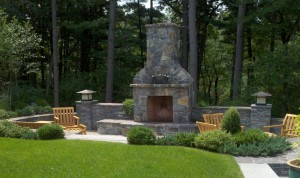
This large outdoor fireplace uses flanking stone walls and a large patio to integrate it into the landscape
An outdoor fireplace is typically a large element in your landscape, so give it the room it deserves. Outdoor fireplaces tend to look silly if they are positioned all alone away from the house. They require a patio or other surrounding hardscape to blend into the landscape. This makes the outdoor fireplace a much costlier fire feature than a fire pit. As with a fire pit, it’s also important to consider if you want your fireplace to be part of your home or a separate entity. Outdoor fireplaces are usually attached to the house itself or on a patio well separated from the house. If it’s placed far away, it will become its own separate social gathering place, separate from what is going on around the house. From our experience, outdoor fireplaces generally work better close to the main house. This is true mostly because their size. If you really want to create a separate gathering area for your outdoor fireplace away from the house, consider including an accompanying structure like a pergola to help blend the large fireplace into the landscape. Give yourself lots of space in front of the fireplace for seating. The larger the patio, the better. Think about where your wood will come from. Consider including a place to stack wood as part your fireplace design.
Wood or Gas? As with fire pits, natural gas and propane are available among other options.
A gas fire element takes away the extra effort of wood and gives a calmer, more peaceful fire. Remember, gas fires take less effort, but are generally smaller, less dramatic, and don’t encourage interaction with the fire. Another element to consider with fireplaces that doesn’t apply to fire pits is the chimney. Wood fireplaces require some sort of chimney for the exhaust of smoke. This increases the size of the fireplace significantly. Gas fireplaces can therefore be much more compact and may possibly be a better choice or smaller spaces.
Other Details of outdoor fireplaces to consider – If we haven’t stressed this enough already, an outdoor fireplace is a large element to add to your outdoor space. They can be spectacular when done right, but can also end up looking clunky and out of place if not done well. All outdoor fireplaces need some kind of patio or similar hardscape to integrate them into the landscape. The size of the patio should be proportional to the size of the fireplace. If the fireplace is tall (as most wood burning types tend to be) consider flanking it with stone walls to give it some horizontal interest. Finally, for very large fireplaces, a pergola or covered porch may be necessary to balance the size of your fireplace.
Finally, Enjoy!
Fire pit or fireplace, wood or gas, remember to enjoy your new fire feature once it’s installed! If you’ve placed it well, it should become a natural part of your family and social environment. Choose your furniture wisely to make your fire feature area comfortable and accessible.
Now you can look forward to years and years of cozy evenings and social gatherings around your new fire feature! Enjoy!



